Stepping out of the pint-sized airport in Mulu is like being vaulted straight into a nature documentary. We’ve already been on Borneo for about two weeks, but it isn’t until we’re walking the 1 kilometer stretch of road from the airport to the grounds of the national park that I really, truly feel that we have arrived. The rest of the country has been nice and given me glimpses of the wildness I came here expecting, but now I am surrounded by so much natural beauty that there can be no confusing where I stand.
As we walk to the park (having stubbornly refused to pay the exorbitant taxi fees when the day is so lovely, our surroundings so pretty, and the distance so insubstantial), the plump marshmallow clouds in the sky offer little coverage from the blazing heat of the sun, and the pounded dirt road we follow is hemmed in on either side by lush meadows, the long grass lazily swaying in the breeze like a hula girl’s skirt, green as far as the eye can see. Gazing up, I lose myself in the endless blue ocean of sky above me, feeling the same slightly vertiginous thrill I do when preparing to plunge into deep water and the clarity of the water and its natural magnification properties have thrown my depth perception off. I wonder if it’s possible for the sky to make me feel a little drunk, just by being so big and so blue. Maybe it’s sun stroke sneaking up on me, but I’m pretty confident that I’ve never seen a sky one could so easily get lost in as the one currently draped over this little patch of the world. Apart from the excited trill of my voice exclaiming about how beautiful everything is, the space around us is silent and sleepy from the heat of a day that has just barely begun.
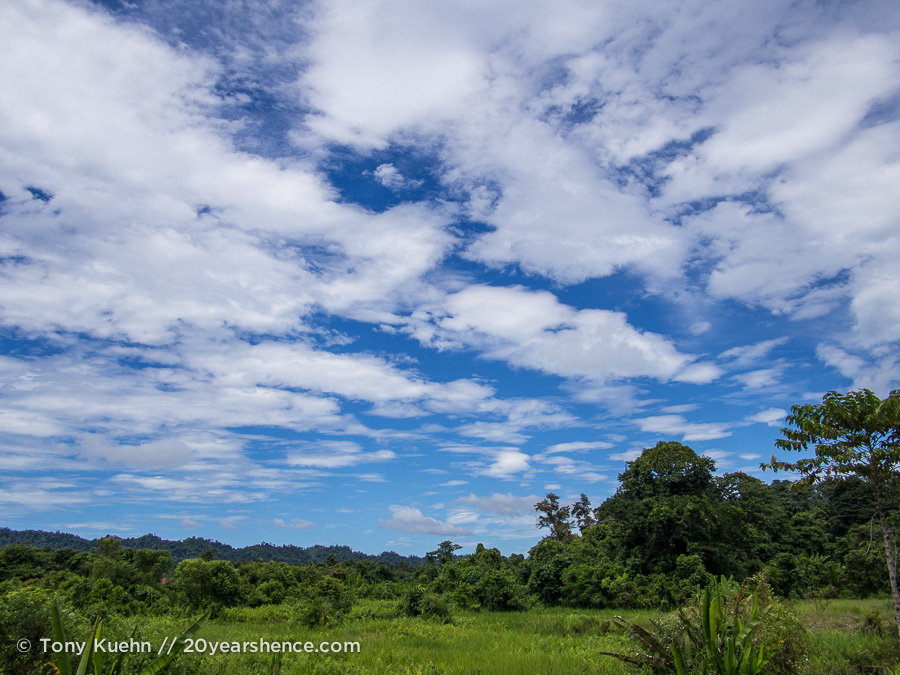
Passing onto the grounds of Mulu National Park, we cross a rickety suspension bridge below which a frothing river rages, and register at the park headquarters. Along with picking up the key to our lodging, we also pick our tours and activities for the next three days. Mulu is famous for several things, but by far the attraction that garners the most travelers is the grueling multi-day trek to a series of jagged limestone peaks known as The Pinnacles. Knowing our limits, we decide that we will be satisfied with a few of the less challenging sites on offer and sign up for tours of the park’s most famous caves as well as a canopy walk that will allow us to take in the rainforest from up in the tree tops.
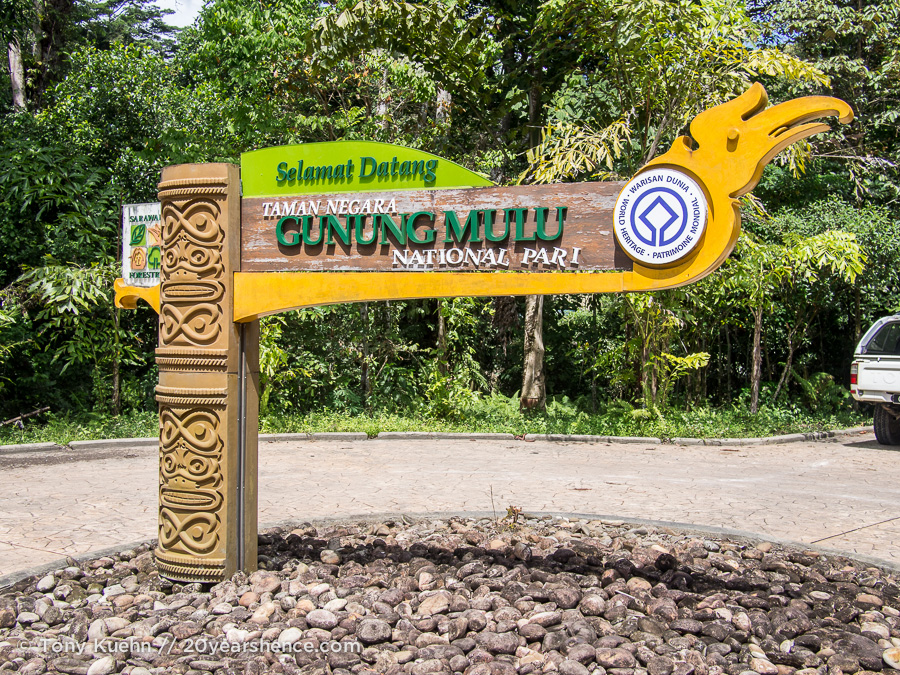
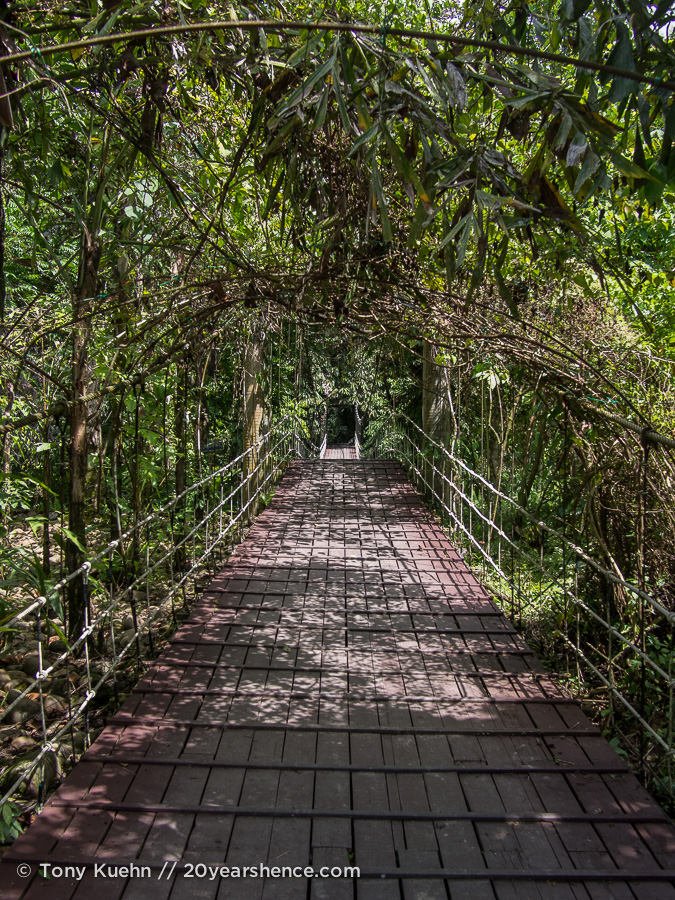
Details and paperwork sorted, we head to our room for the next three nights—we’re staying in the park’s dormitory, and the building feels a bit like I imagine you’d find at a summer camp for scrappy orphans. If that sounds unpleasant to you, I assure you it isn’t, as the rooms within have large windows (with quality screens), ceiling fans, and no more than four cots to a room so as to avoid the dreaded “sardine” syndrome that is all too common in low-budget communal bedrooms; other than the lack of doors on all the rooms, there’s really not much to complain about. We manage to find a room near the back with only three beds and claim two of them with our stuff, hoping that any interlopers will feel awkward about having to room with a couple and bunk elsewhere. Given that we’re each only paying $13US for our room, we were expecting a lot less; it is clean, the beds are comfy, the other people in the building seem to understand that dorms should be quiet spaces to foster sleeping, so we can’t really ask for much more.
We nap for a little bit and grab some lunch from the canteen before moseying over to the meeting point for our tour of Lang and Deer caves. The group is small, just ourselves, our gregarious guide Jesper, and a Dutch girl named Esther, one of those formidable people who runs marathons and actually enjoys inflicting pain on her body. She has recently returned from summiting the Pinnacles and the trek has taken a real toll on her body as she can barely push herself past a feeble hobble… which means she perfectly matches our own normal pace! We’re all a bit worried because we’ve been told it’s a three kilometer hike to the caves, but thankfully, the word “hike” turns out to be more than a little misleading. The entire route is either paved or on an elevated wooden walkway, is essentially flat, and not the least bit taxing. It may detract ever so slightly from the notion that we are roughing it in the jungles of Borneo, but I’ve got a good imagination and would rather have a relaxing stroll around nature rather than right through the thick of it, complete with leeches and other creepy crawlies.
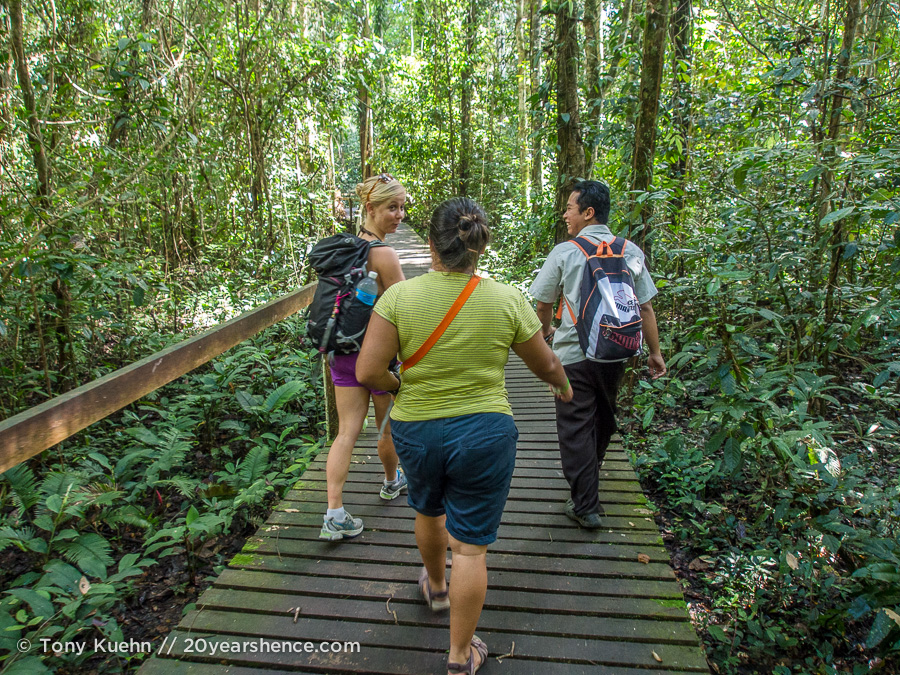
The only downside to the path that I can see is that it is so obvious and easy to navigate that it makes the requirement that one have a guide supremely unnecessary and an obvious cash grab. Given that I would actually have to climb over barriers in order to stray from the path and get lost, I am a little bit annoyed, but Jessper soon pulls me out of my funk with his cheerful attitude and by pointing out adorable pygmy squirrels, which are from nose to tail, I kid you not, no bigger than the length of my middle finger (so, about 8 centimeters). Borneo: land of big open spaces and miniaturized animals… who knew?
The first cave we visit is Lang Cave, which is a bit like entering your grandmother’s attic… provided your grandmother has an attic and it is filled with stalagmites, stalactites, pygmy bats (See! More tiny animals!), swiftlets, and creatures that look like cobwebs but are actually carnivorous worms (as if cobwebs weren’t disturbing enough as they are!). We work our way through the cave, marveling at the many formations that have erupted from the cave due to the constant trickle of high salinity water on the limestone over the centuries. Lang Cave is highly atmospheric and just a little bit eerie, exactly the way I always imagined a trip to Borneo would be.
Next, we head to Deer Cave, thus called because deer were once attracted to the cave due to the high salinity of the water there. Why is the water so salty? Because of the high concentration of bat guano that falls into it! For that reason, Jesper warns us to keep the tops on our water bottles tightly sealed when inside the cave and we should probably refrain from looking up with our mouths gaping open in astonishment. Duly noted.
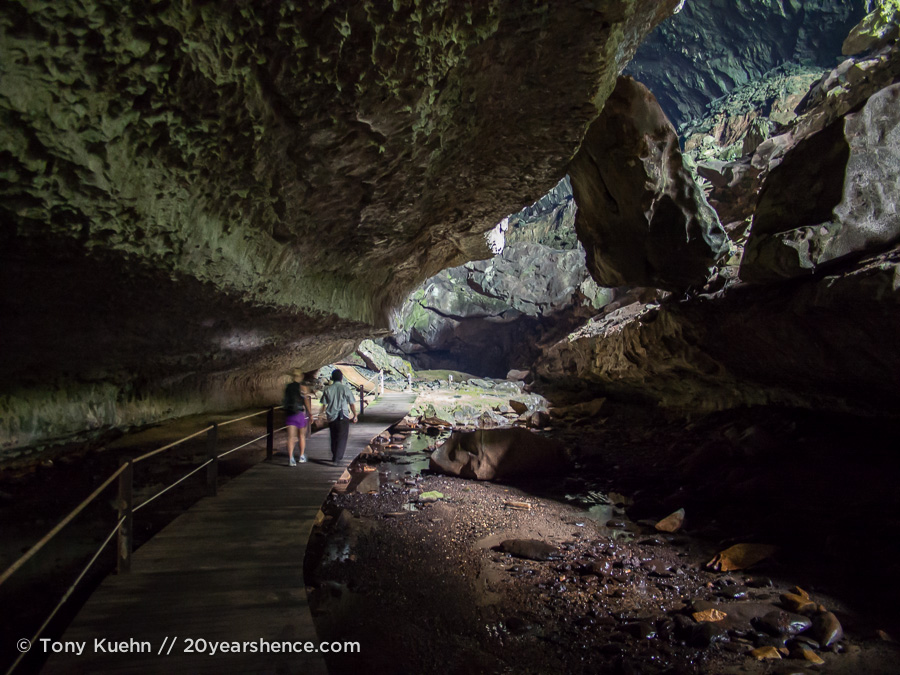
I’m glad Jesper gave us that warning because every so often we do things on this trip that are so surreal that I do stand there gawking like I’m doing my best slack-jawed yokel impression. Entering Deer Cave is definitely on that list of mind-boggling experiences. It is the largest cave system in the ENTIRE WORLD, and like the meadows and sky leading up to that moment, it is just so MASSIVE it truly defies comprehension. Standing there, I feel like a grain of sand in a giant’s palm, completely insignificant and so very, very tiny.
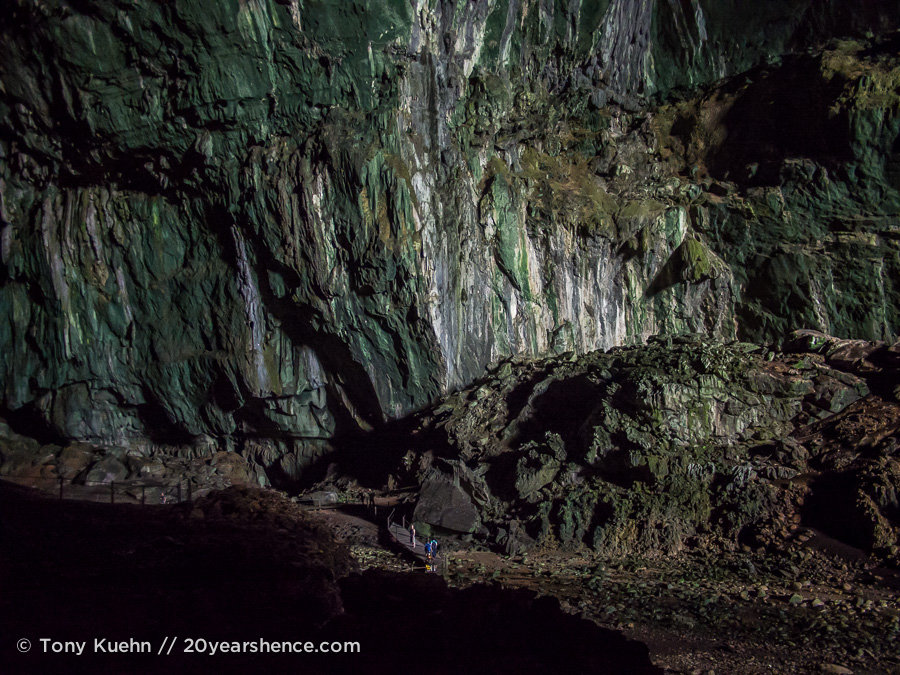
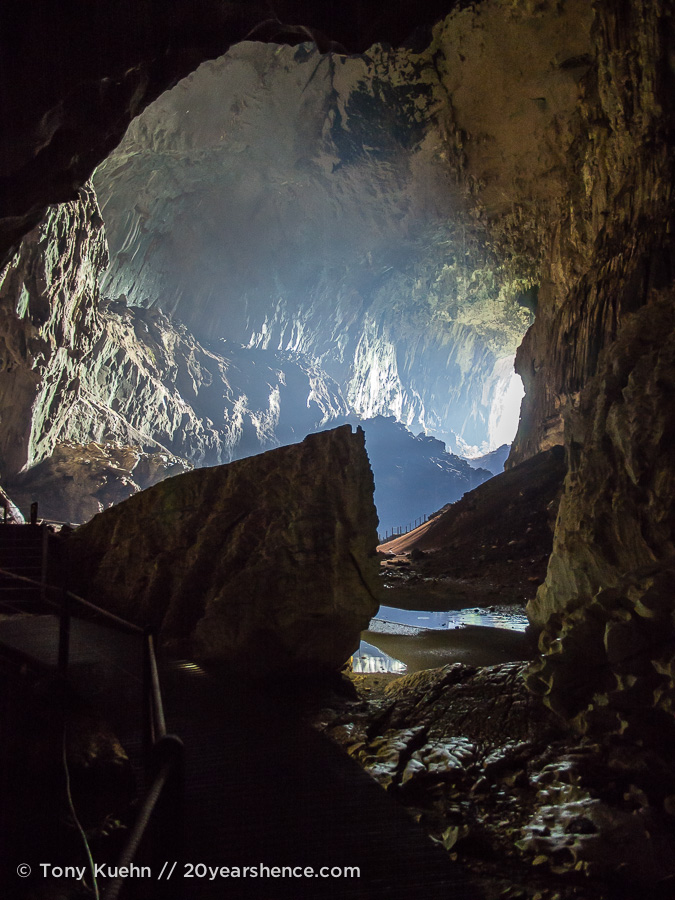
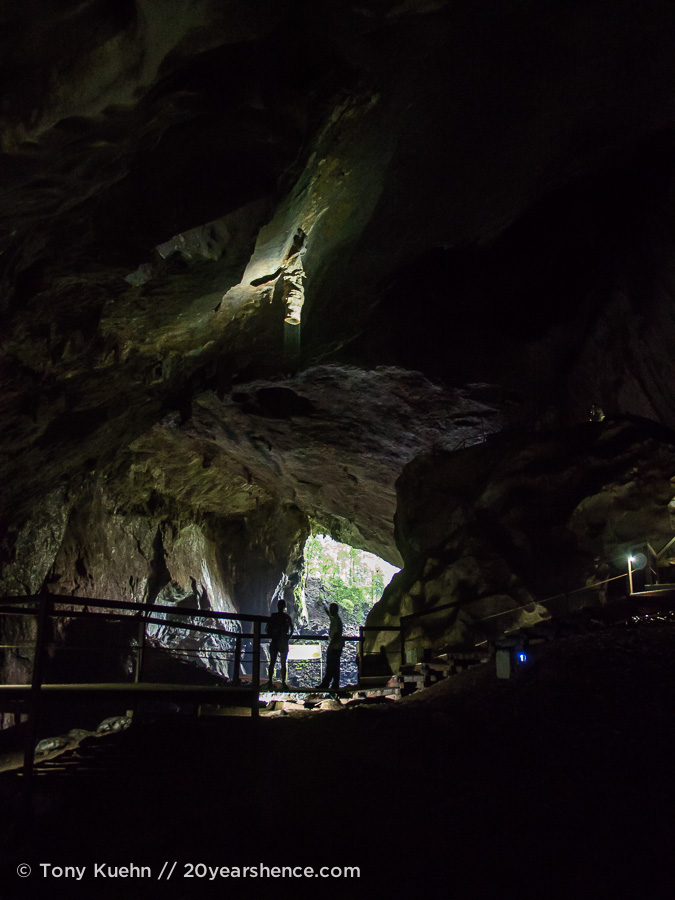
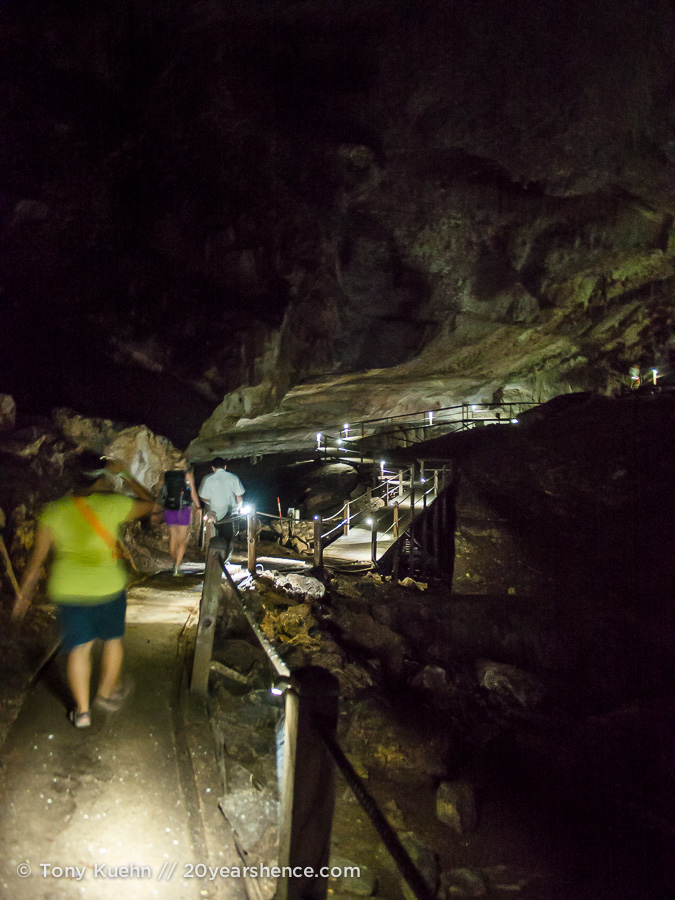
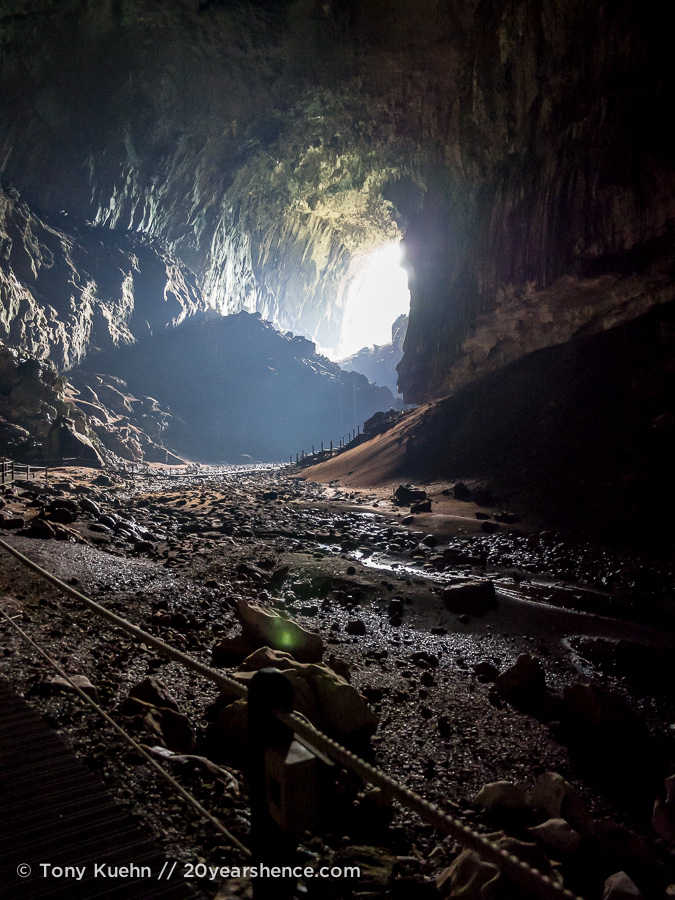
As we make our way through the massive cavern, we hear the leaf-thin wings of millions of bats fluttering above us, echoing off the stone. I risk a quick peek or two upwards hoping to catch some glimpse of them, but they are so high up and the cave is so dark it is like trying to peer into a black hole. One upside to the complete absence of light is that it allows us to see some nifty phosphorescent centipedes that continue the trend of Borneo blowing my mind as they actually glow green as they writhe and undulate in Jesper’s palm (all the while defying any and all attempts to capture them in photos, naturally).
We only see a fraction of Deer Cave, but the place is so huge, it takes us nearly an hour to explore it anyway. Jesper ushers us out late in the afternoon to go sit by one of the entrances in the hopes that come dusk, we’ll be able to witness a mass bat exodus where the creatures rouse themselves from slumber and take the sky en masse to hunt for bugs. Alas, as we are at the tail end of the rainy season, Jesper warns us that it is likely too cold and the impending rain (of which we detect not a trace) will keep the bats safely sequestered inside the cave.
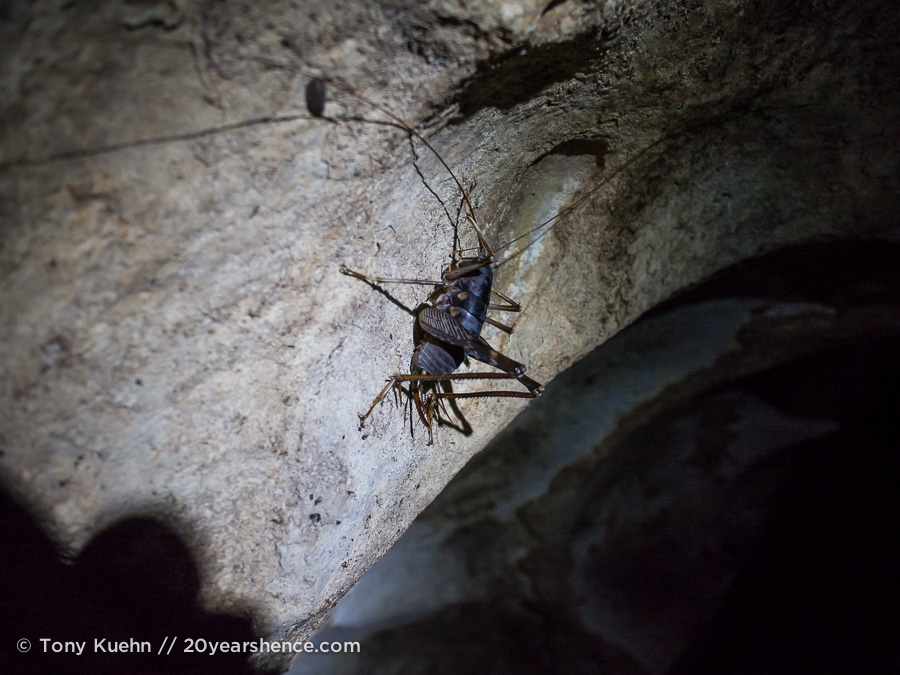
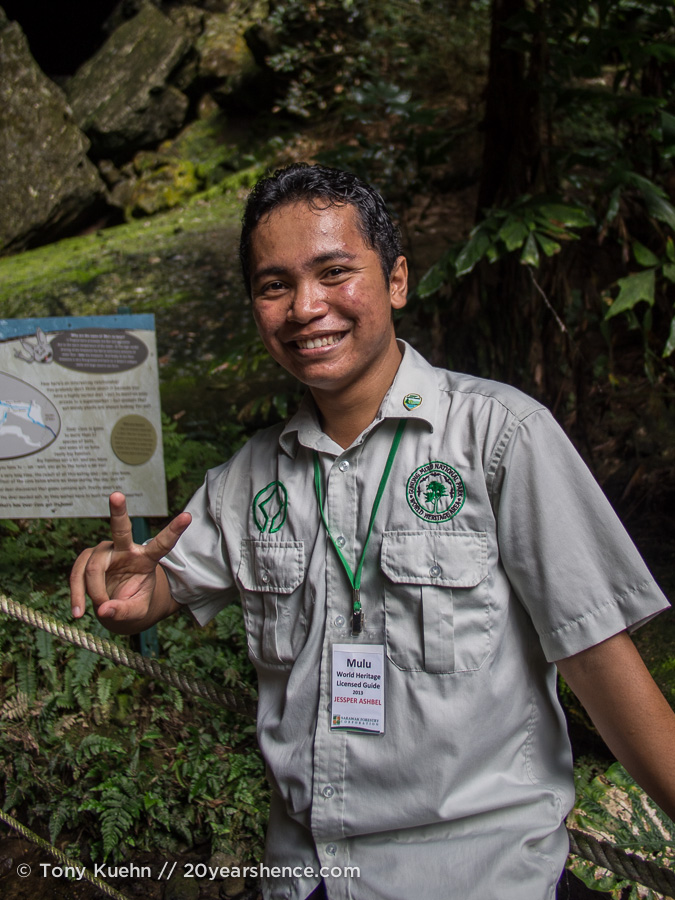
We wait for an hour but apart from a few swooping swiftlets cutting graceful arcs through the air, Jesper’s premonition of quiet skies proves true. That evening as we are tucking ourselves into bed, an ominous rumble shakes the air around us, prefacing the fat drops of rain that soon begin to tumble. Clearly Jesper and the bats were right about the weather! We drift off to the susurrus of rain in the trees, its gentle tap-dance across the roof a soothing lullaby after the day’s sweaty adventures.

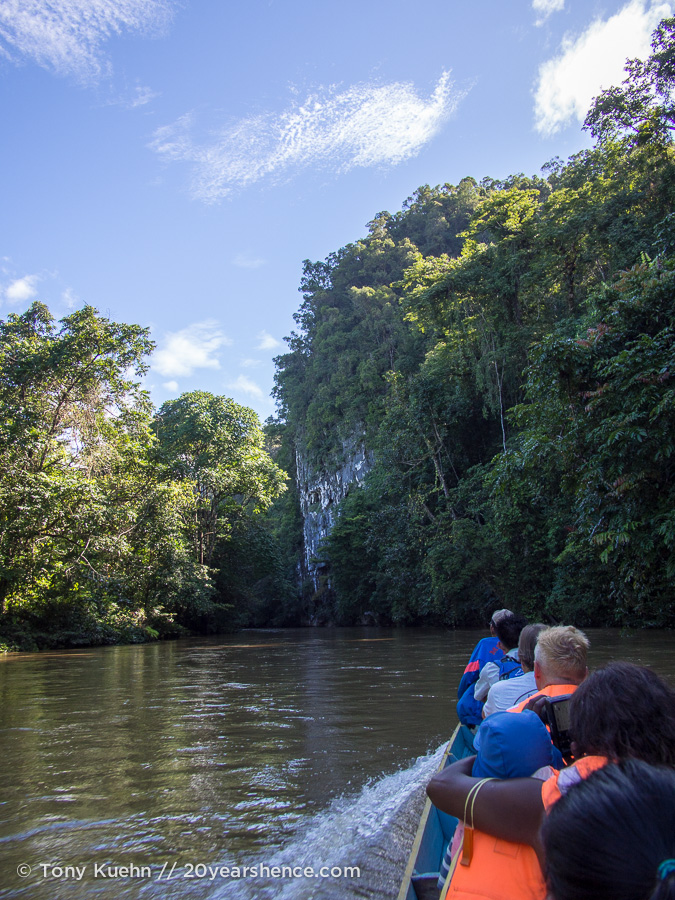
The next day, we wake up early feeling eager for another day of adventuring. We have signed up for a tour of Wind Cave, which can be reached by foot or by boat… we immediately make our way down to the river and step into a small canoe that is soon nosing its way into the jungle. En route, we are taken to a tiny tribal village that sets up a small market beside the river—it is meant to give us a taste of the local way of life, but it is very quiet and mostly just serves to make us feel awkward and guilty because everything that is on display has clearly been done with cash-happy tourists in mind. Our guide for the day is actually from the village originally and tells us that many of the people trying to sell us things have come from the surrounding woods and they come here for the small chance of selling something to tourists and making some money… it is their only potential source of income.
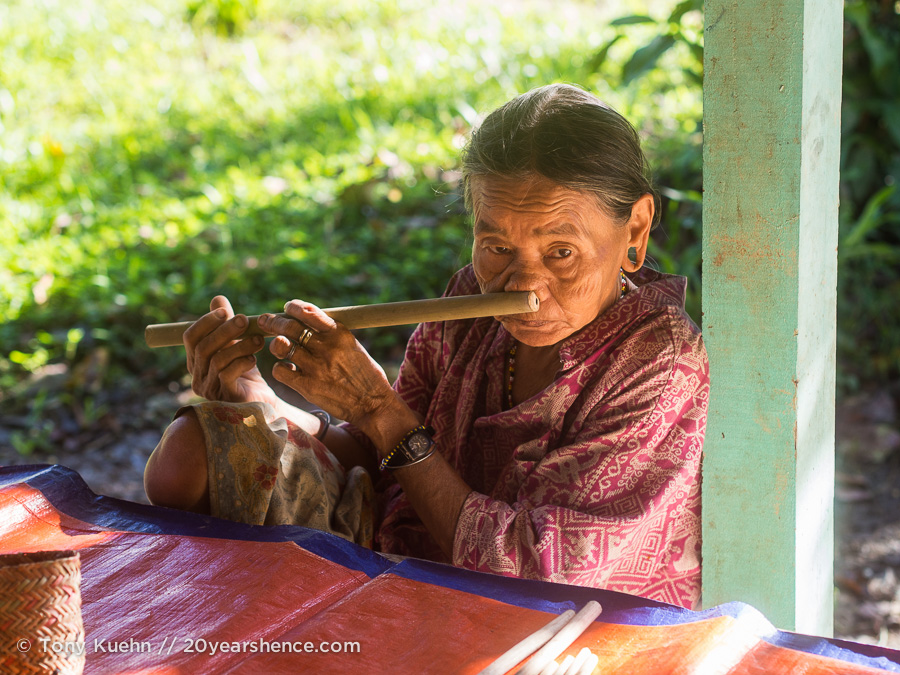

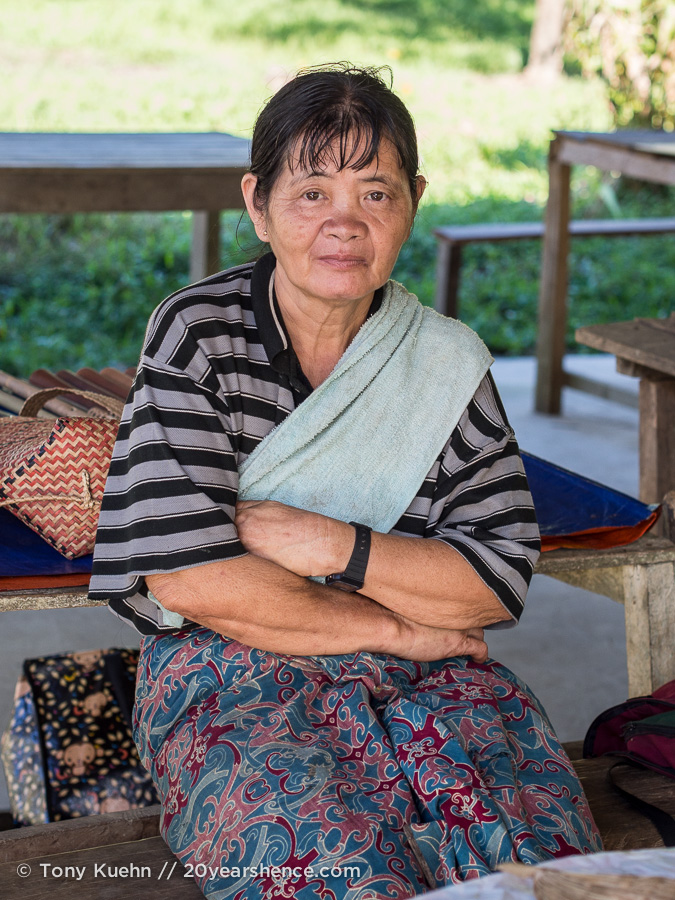
I am not necessarily upset that these locals have decided to try to make tourism work for them and try to get a piece of the national park’s pie, but there is a quiet desperation to the place that makes me think that tourism has disrupted the ecosystem of the area as the locals have perhaps come to rely on tourist money more than they should. It is an unsettling start to the day and a good reminder for us as to why we normally avoid package tours where shopping stops are routine; I have become very good at cutting out unnecessary shopping in our lives, justifying our frugality by saying we don’t need most of what these people are selling. But what if they need us to buy? Our group of five are the only people at the market, so the pressure to buy something is immense, and although I really do not want anything, Tony & I elect to purchase a few small key chains that we can use as zipper pulls on our backpacks (agonizing over the fact that we only purchase from one woman when there are 12 other sellers who go without).
Our small purchases in hand, we get back into our tippy little boat that dips worrisomely low in the water with five westerners inside it (even if one of them is a five-year-old boy). Our guide revs the engine and we zip along the river and feel incredibly intrepid although we are doing nothing more than sitting there. We are told that the river is normally crystal clear, allowing you to see all the way to its bottom, but the previous day’s rain has turned it to the opaque shade of milky coffee.
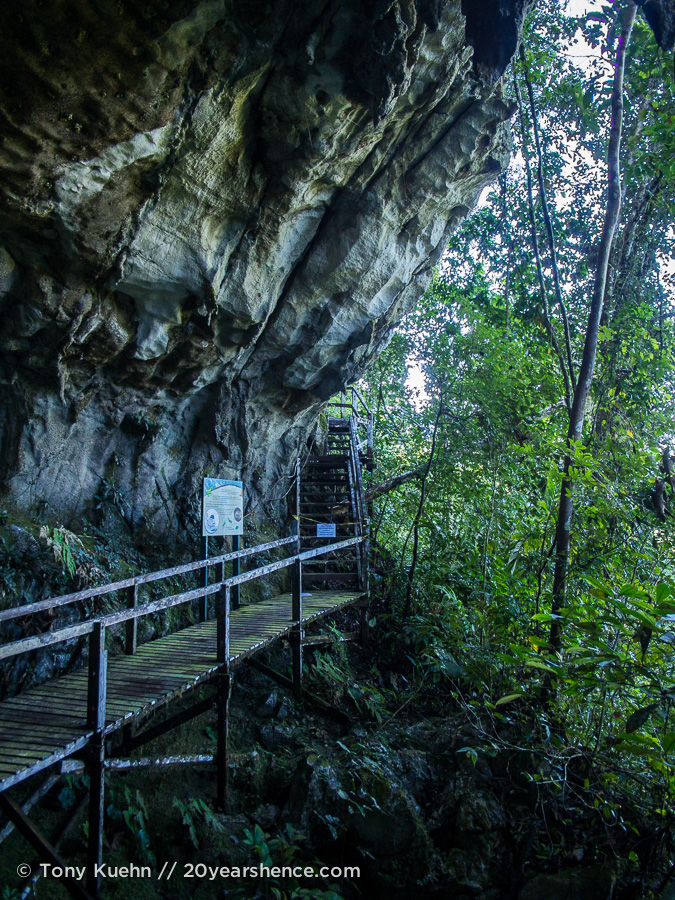

Unexpected diversions aside, our next stop is Wind Cave, which despite its name, is not windy at all, and is instead stuffy and close inside. We brave the stifling heat to walk through its tunnels lined with moonmilk and wonder how a place that seems ripped straight from a video game can exist naturally on our planet. As we enter the section the cave called the King’s Chamber, Tony and I whisper about the likelihood of treasure chests and Skyrim’s draugers, our stifled giggles echoing off the high walls of the chamber.
Back outside, we pile into the boat and get on our way to Clear Water Cave, which can only be reached via 200 steep steps. We figure this is penance for skipping out on Yamadera when we were in Japan and get to work. When we reach the top, we are rewarded with an expansive cave that is reminiscent of Deer Cave, but for a huge river running straight through the middle of it. It also features some beautiful natural skylights and some very cool elevated walkways.
Due to the murky state of the river, we demur at suggestions of jumping in for a cooling swim, and instead head back to the park headquarters to grab some lunch. Then it’s off to the heart of the forest where we do the Canopy Walk, a tour that is supposed to take about 2 hours but winds up only taking our group 45 minutes largely due to the fact that half of the people signed up are terrified of heights and can’t stand to be on the rickety rope bridges 30 meters above the forest floor any longer than they have to. Why we did not consider that Tony’s crippling fear of heights might be problematic when we signed up for this tour, I cannot say, only that neither of us seemed to think it would be an issue at all until we were actually up in the trees. Tony is light-headed and terrified for the entire tour, but he is a trooper and makes it through the whole circuit, though sadly gets little enjoyment from it. I think it’s quite exhilarating to be so high up, and although I’m disappointed we don’t see any wildlife, the views from on high are spectacular.
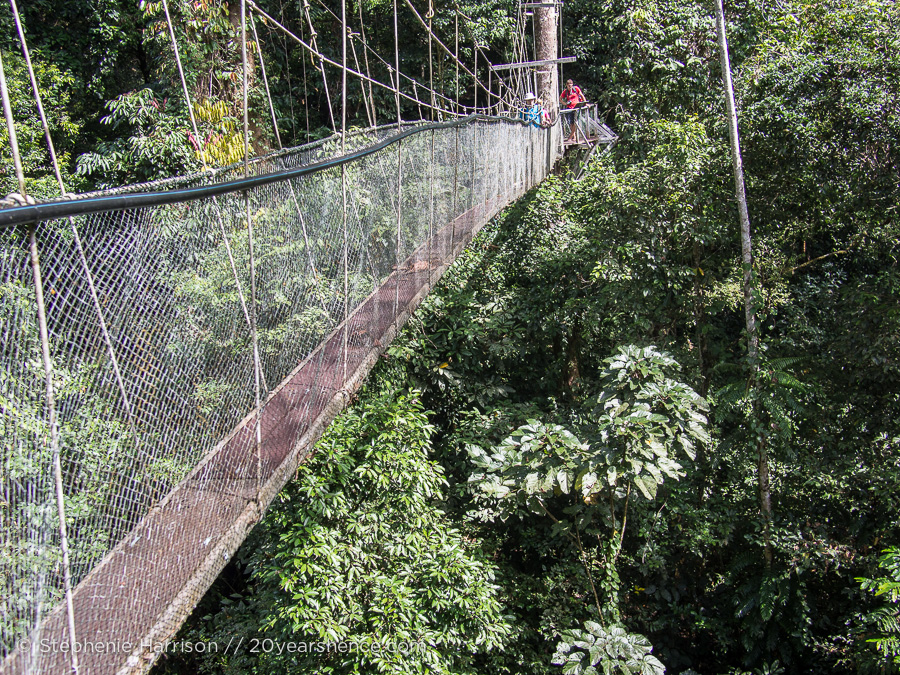

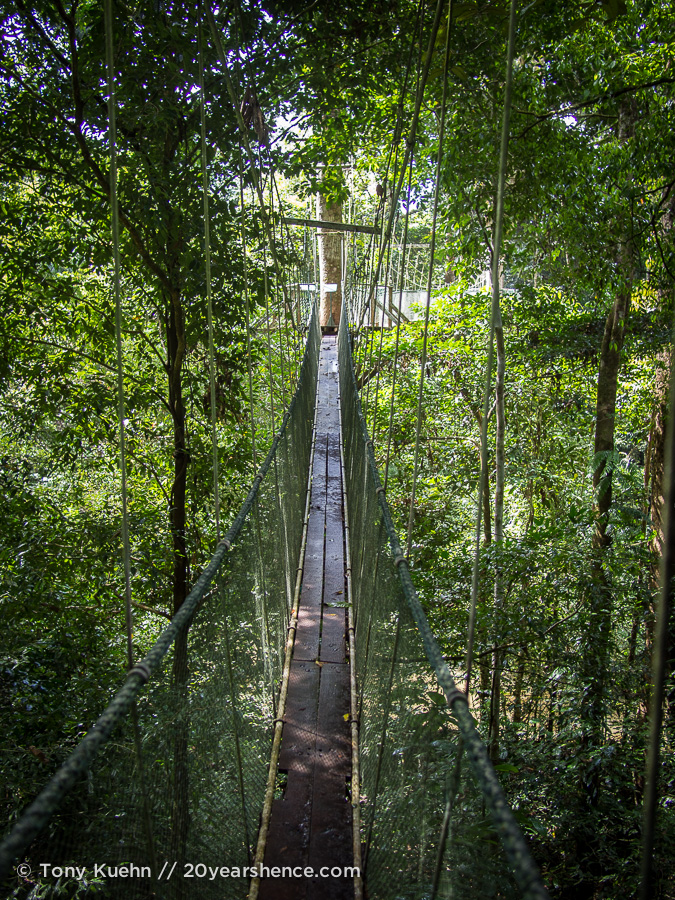
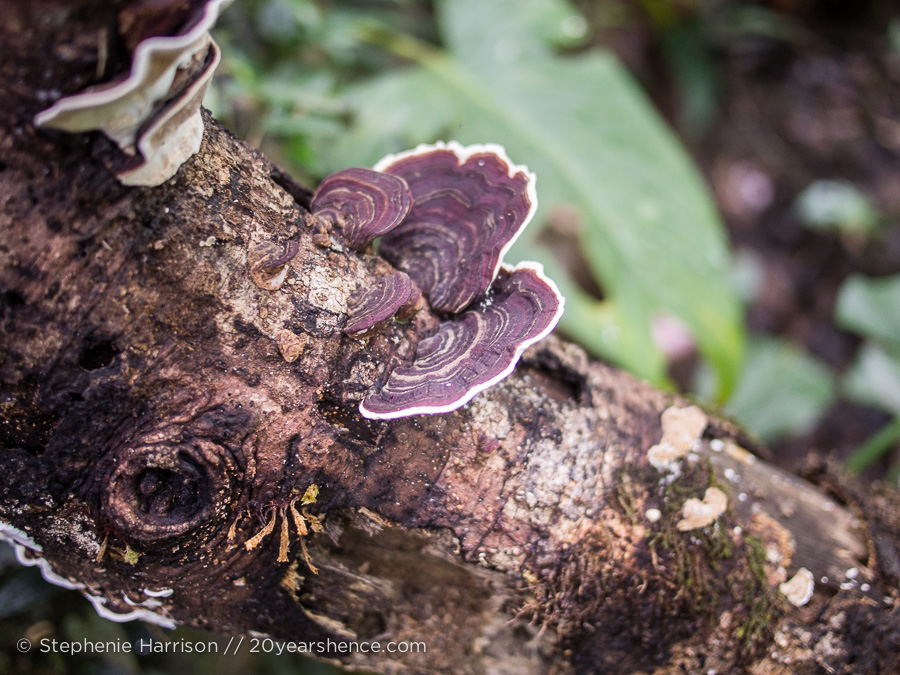
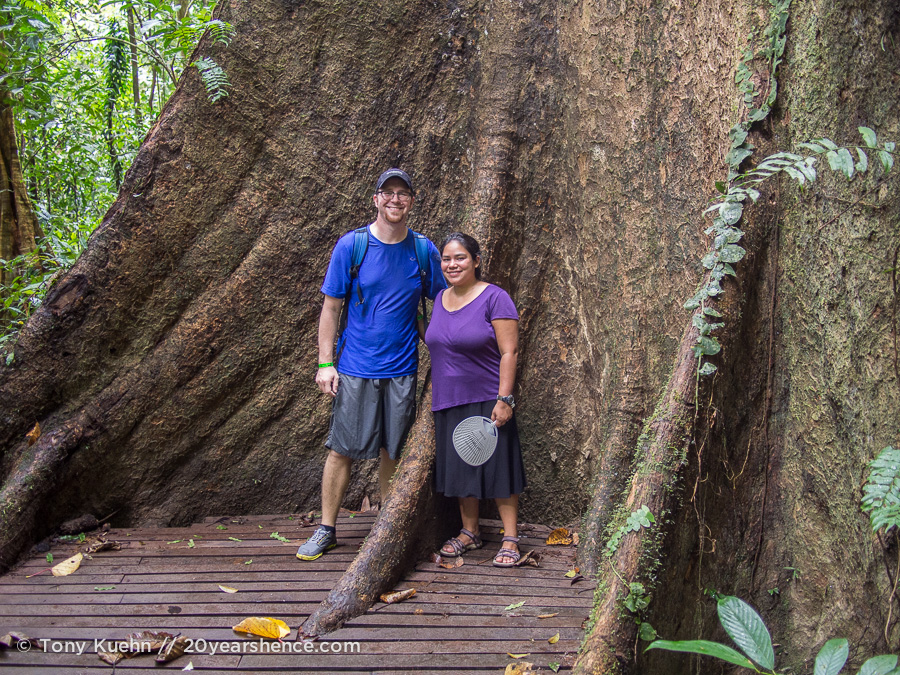
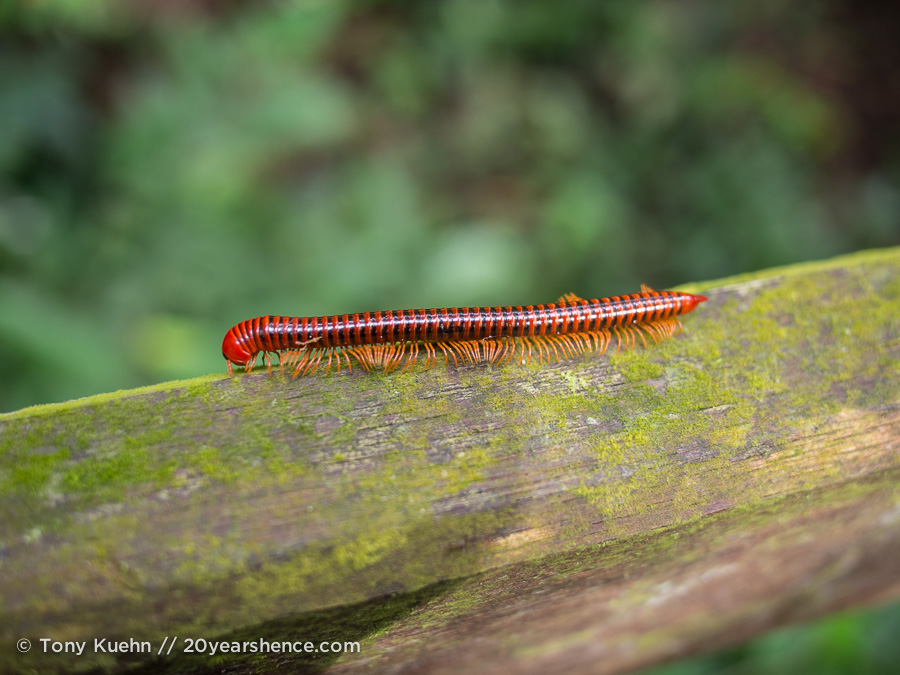
As we descend from the treetops back to solid ground, our adrenaline begins to ebb and our energy levels slump accordingly. We stroll lazily towards Deer Cave and hunker down with a sleeve of cookies to tide us over as we wait once more for the bats to grace us with their dinnertime flight. Alas, tiny drops of rain begin to smatter us during our vigil, and so all we get for our patience is the occasional tendril of bats, flitting about like shimmering funnels of smoke, something akin to the smoke monster from Lost. It may not be the full-blown exit, for us or the bats, but it is still quite cool to watch their flawless choreography as they twirl about in perfect synchrony, a gestalt cloud of activity.

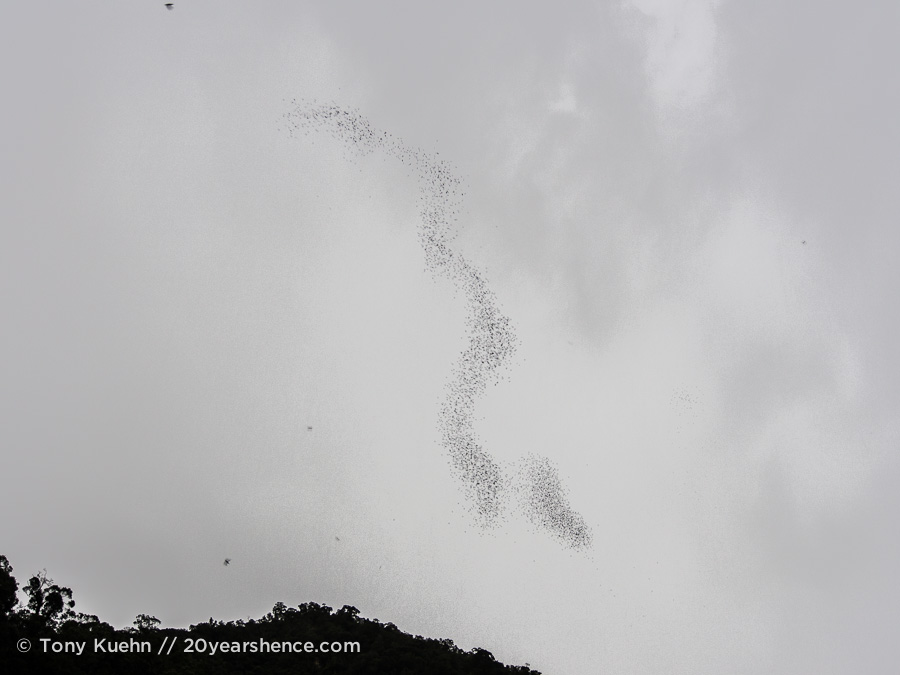
As a bonus, here’s a little video (set to groovy music) of the bats zipping around the sky!
We spent three days at Mulu, nestled in the center of the park simply rejoicing at being surrounded by so much glorious nature. As someone who considers herself a city girl through and through, it was something of a revelation. We rejoiced in being outdoors in unadulterated, unbridled Borneo, walking anywhere between 9 to 10 kilometers each day in our explorations, and then relaxing late into the evenings with books and ice cream and the nocturnal sounds of the forest chirping in symphony around us. Of the three weeks we spent on Borneo, I don’t think we ever felt like we were closer to its heart than we did at Mulu.
We only did a small sampling of the activities on offer at Mulu, and although we did visit its very best caves, we never did witness the epic bat exodus in its entirety. I guess that just means that one day we’ll have to go back. I can’t wait.
What beautiful, beautiful pictures, and your descriptions are so vivid. The images of the formations in the caves are gorgeous, and the pictures from what I’m assuming is the Wind Cave, and the journey there, are stunning. Thank you so much for sharing- this one’s going on the bucket list!
So glad you enjoyed reading our account, Tim. It was hard to do Mulu justice with mere words, and it was actually quite a tough place to capture photographically (everything was SO BIG!), but we did our best. I hope you do get to visit one day—it’s honestly awesome!
Hi Steph, I enjoyed your Mulu adventure. I have not heard of Mulu before and I so want to go there now. The caves are spectacular. I can’t believe how immense they are. The photos are so stunning, as usual. I enjoyed the video. I thought the bat choreography was so amazing.
I know what you’re saying about some locals’ over reliance on tourism. As much as we don’t want to give in to impression that tourists = $, sometimes compassion takes over and we end up buying something small, especially in places where business seem slow.
I really think you and Keith would adore Mulu! It’s exactly the kind of outdoor adventure I’m sure you guys would love. And I bet you two could even tackle the Pinnacles! 😉
When it came to the market that we visited, I did feel it was an instance where our compassion took over and forced us to open our wallets at bit. It wasn’t high season while we were at the park so we knew that if no one in our group bought anything, the venders would all go home empty-handed and we just couldn’t handle that. We never want to be seen as walking ATMs, but in certain instances, your heart takes over and you just do your best to make a bad situation a little bit better.
It sounds like an amazing place to explore, and I can see why you felt to be in the heart of Borneo! I love your descriptions- I felt like I was right there journeying through Mulu with you! I love the photo of the woman playing the flute with her nose- how interesting!
There are still a lot of incredible places to visit in Borneo, but this really was the place where we felt the most off the grid and in the heart of untamed wilderness.
The nose flute was definitely novel… she kept playing it vigorously and then trying to get us to buy one, but we figured we’d never be able to match her talent! 😉
Great pictures and story, glad you’re having a good time . . . Pop
Glad you enjoyed it! We really had a blast at Mulu. 😀
Tony, your photos in this post are outstanding. I also like the bat video! BATS!
Happy to hear you enjoyed the video, since we rarely think to actually take video rather than photos. But in order to really appreciate the crazy bat choreography, you need the movement that a video provides, I think.
Looks like an amazing experience!
It really was! The funny thing is that it was our friend in Singapore who turned us on to Mulu… when we told him we were going to Borneo, he was like, “Oh! You’re definitely going to go to Mulu, right?” The first time he mentioned it, we had no idea what he was talking about!
Now this is my sort of adventure, it looks fantastic. Once again I’d not heard of Mulu which is pretty shameful given it’s the largest cave system in the world! Great photos as always.
You and Paul would love this, I just know it. I’m not sure how it compares to Sumatra, but this was definitely our favorite place in Borneo. Given how much you guys love a hike, I think this would be paradise for you!
I love caves and these look amazing; the treetop trek sounds like fun too. Andrew and I stopped briefly at Mulu airport to change planes on our way to Kota Kinabalu; now I wish we’d stayed at the park for a few days too. I think we vaguely considered it but we had the idea it would be too expensive, especially considering how much we were spending in our quest to glimpse wild orangutans. With those dorm rooms though it looks like your stay in Mulu was quite affordable by Borneo standards.
Oh, I can’t believe you and Andrew were so close! I think you guys really would have loved Mulu, but I know you loved Borneo in general so I’m confident you’ll go back and give it a shot. The dorms really made our stay their pretty reasonable, and if we had been more intrepid and not wanted to book lodging in advance, there were several guesthouses located just on the fringes of the park that are supposedly even cheaper. All things considered, we didn’t find our time at Mulu too terribly expensive—food was a tad pricier than elsewhere, but not horribly so, and if it were possible to do some of the walking tours on your own that would really cut down on costs. When you factor out the cost of the flights to and from the park, we spent about $60/day for the two of us on everything… so, really not too bad!
This looks so awesome. Tony’s photos, especially the ones in the cave, are absolutely breathtaking! I really love caving – there’s something about heading into the Earth that is so unsettling in the very best way possible. It’s amazing to see the animals that thrive in such a bizarre environment.
I definitely understand where you are coming from with the “shopping stops”. To be honest, I would rather just pay a few extra dollars and have more time at the sites I really want to see – that way I can get what I want, and the people that need the money can get what they want. If I have to stop at a shopping location, I much prefer when it is a “”collective”, and I don’t have to feel guilty about who I buy from.
Oh, and it’s always nice to see a Skyrim reference! Safe travels!
Neither of us are huge cave aficionados, but even we could really appreciate what Mulu has on offer. It really was breathtaking to be in some of those spaces, visions of draugers filling our heads and all! 😉 (So glad you appreciated the Skyrim references! We also kept saying “I used to be an adventurer until I took an arrow to the knee…” throughout our trip.)
Unfortunately in Asia it’s nearly impossible to do organized tours without mandatory shopping stops built in, no matter the initial cost of the tour… it’s part of why we try to travel independently as much as we can. That’s the only way we can ensure that we’re stopping at the places we want to stop and buying things from the vendors we actually want to, rather than out of feelings of guilt.
Cool photo of the bats! It really does look like the smoke monster from Lost. (I was actually thinking about that show much earlier into this post.) I’ve been in some pretty fantastic caves – Gibraltar, Halong Bay – but these are unbelievable! I could do without the carnivorous worms, though. *shiver*
Yeah, I have to admit, after Mulu, I think we’ve been pretty much ruined for all other cave experiences. I mean, once you’ve been to one of the best, it’s hard to get excited about any of the other ones, especially since we’re not super passionate about caves to begin with. We’ve done a few other cave tours here and there and for the most part enjoyed them, but it’s hard to hold a candle against Mulu… carnivorous worms and all!
I loooove caves! This looks amazing. I also love the idea of walking up in the trees like that. There’s a tree walk in Australia that I’d love to do. Here’s hoping it’s not exorbitantly expensive.
And no disrespect to that lady with the flute, but all I could think of was, “And with a flute stuck up his nose, Ralph Wiggum.” Sigh.
I did not have you pegged as a cave lover, but if that is the case then you guys definitely have to make it to Mulu at some point. Seriously very cool.
I just don’t know about the nose-flute thing. I guess it might be easier than playing it with your mouth, but also grosser too…
Great writing and especially photography! I am just getting started with traveling and blogging and appreciate the inspiration! Will be back regularly to check your page out.
Thanks for stopping by & taking the time to comment. Glad to hear you are enjoying the site!
Hi there, I visited Mulu back in the early 1990s, before the nearby airport was built and one had to make one’s way there on river boats from Miri. Found it jaw-droppingly amazing like you did — with the highlight being the sunset flight of the bats out of the main (Deer) cave that, all told, went on for more than one hour — because there were so many bats in there.
I’m sorry you missed it, and hope you will return some day to see that spectacle. For my part, I want to return for the Pinnacles. Some day…
You can still get to Mulu by boat, something we had considered, but when we saw how long it would take and the costs involved, it wound up making more sense for us to just hop on a plane. What an adventure it must have been to go the way you did!
Really wish that we had been able to see the full bat exodus, but I suppose that’s the risk you take when you travel in the low season. Not sure if I’ll ever have it in me to tackle the Pinnacles, but I’d love to go back and try again with the bats.